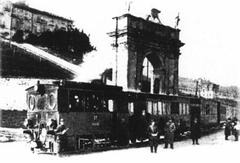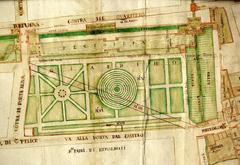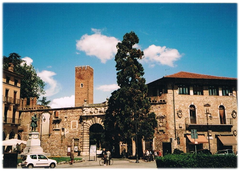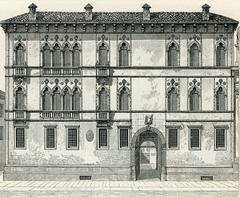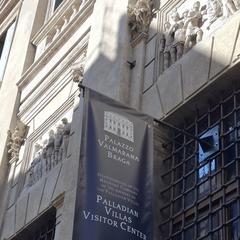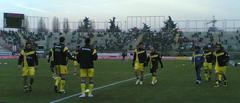Guide to Visiting Buso della Rana in Vicenza, Italy
Date: 01/08/2024
Introduction
Nestled in the picturesque Monte di Malo in the Province of Vicenza, Italy, Buso della Rana is a site of immense natural beauty and historical significance. Known as the largest cave system in the Veneto region, it extends nearly 40 kilometers, offering a fascinating glimpse into Earth’s geological past (Musei AltoVicentino). The cave’s rich history dates back to prehistoric times, with archaeological evidence suggesting it was frequented by ancient populations for shelter and possibly ritualistic purposes (Il Giornale di Vicenza). During the medieval and Renaissance periods, the cave’s strategic location made it a valuable refuge, shrouded in local legends and folklore. Its name, ‘Buso della Rana,’ translates to ‘Frog’s Hole,’ likely derived from these ancient tales. In the modern era, Buso della Rana has been extensively studied by speleologists, recognized as a Site of Community Importance (SCI) under the European Union’s Natura 2000 network, highlighting its ecological and geological importance (Buso della Rana Official Website). This guide will take you through the cave’s historical, geological, and cultural significance, providing essential visitor information, travel tips, and insights into conservation efforts to ensure a memorable and educational visit.
Table of Contents
- Introduction
- Historical Significance of Buso della Rana
- Geological and Hydrological Significance
- Cultural and Educational Impact
- Visitor Information
- Conservation Efforts
- Integration into Local Culture
- Practical Information
- Additional Activities
- FAQ
- Conclusion
Historical Significance of Buso della Rana
Prehistoric and Ancient Use
The Buso della Rana cave system has a rich history that dates back to prehistoric times. Archaeological evidence suggests that the cave was frequented by prehistoric populations. Artifacts discovered at the entrance area and the nearby Maddalena quarry indicate that early humans utilized this natural labyrinth for shelter and possibly for ritualistic purposes (Il Giornale di Vicenza).
Medieval and Renaissance Periods
During the medieval and Renaissance periods, the Buso della Rana continued to be a site of interest. The cave’s strategic location and its complex network of tunnels made it a valuable refuge and a place of mystery. Local legends and folklore often mention the cave, attributing it with magical and mystical properties. The cave’s name, ‘Frog’s Hole,’ likely derives from these ancient tales.
Modern Exploration and Scientific Studies
In the modern era, Buso della Rana has become a focus of scientific exploration. Speleologists have extensively studied the cave, recognizing it as a Site of Community Importance (SCI) under the European Union’s Natura 2000 network. This designation highlights its ecological and geological importance (Buso della Rana Official Website).
Geological and Hydrological Significance
Formation and Structure
Buso della Rana is the largest cave system in the Veneto region, with nearly 40 kilometers of mapped passages (Musei AltoVicentino). The cave’s formation dates back to the Priabonian stage of the late Eocene epoch, approximately 37 to 34 million years ago. This period is characterized by significant geological activity, including the deposition of limestone, which forms the primary rock type within the cave system.
The cave’s intricate network of tunnels and chambers was primarily formed through the process of karstification. This geological process involves the dissolution of soluble rocks, such as limestone, by natural acidic water, leading to the creation of underground voids and passages. The presence of stalactites, stalagmites, and other speleothems within Buso della Rana provides evidence of ongoing mineral deposition, which continues to shape the cave’s interior.
Speleological Features
Buso della Rana is renowned for its diverse speleological features. The cave system includes several notable sections, such as the Sifone, Lake Caronte, Cameron dei Massi, Ramo dell’Argilla, and Ramo delle Marmitte (Musei AltoVicentino). Each of these sections offers unique geological formations and environments:
- Sifone: This section is characterized by narrow passages and water-filled siphons, requiring specialized equipment and techniques for exploration.
- Lake Caronte: A subterranean lake that showcases the cave’s hydrological dynamics and the interaction between groundwater and the cave system.
- Cameron dei Massi: Known for its large boulder formations, this section highlights the cave’s structural complexity and the impact of geological forces.
- Ramo dell’Argilla: This branch features clay deposits, indicating past hydrological activity and sediment transport within the cave.
- Ramo delle Marmitte: Notable for its potholes and cylindrical depressions, formed by the erosive action of water.
Hydrological Significance
The hydrology of Buso della Rana is a critical aspect of its environmental importance. The cave system acts as a natural reservoir, storing and regulating groundwater flow within the region. The presence of subterranean lakes and streams within the cave highlights its role in the local hydrological cycle.
The cave’s hydrological dynamics are influenced by several factors, including precipitation, surface water infiltration, and geological structures. Understanding these dynamics is essential for managing water resources and ensuring the sustainability of the cave’s ecosystem.
Cultural and Educational Impact
Biodiversity and Ecosystems
Buso della Rana is not only a geological marvel but also an important ecological habitat. The cave system supports a variety of subterranean fauna, including troglobites (organisms adapted to live in complete darkness) and troglophiles (organisms that can live both inside and outside caves). These species have evolved unique adaptations to survive in the cave’s dark, humid, and nutrient-poor environment.
Key species found within Buso della Rana include:
- Cave-dwelling bats: Several bat species use the cave as a roosting site, contributing to the cave’s ecological balance by controlling insect populations.
- Invertebrates: The cave hosts a range of invertebrates, such as spiders, beetles, and crustaceans, which play crucial roles in the cave’s food web.
- Microorganisms: The cave’s unique microclimate supports diverse microbial communities, which contribute to nutrient cycling and the formation of speleothems.
Educational Programs
Educational programs and guided tours play a crucial role in promoting sustainable tourism and raising awareness about the cave’s significance. These programs are designed to provide visitors with an in-depth understanding of Buso della Rana’s geological, ecological, and cultural importance.
- Museum Educator Tours: Guided tours led by museum educators offer insights into the cave’s history, geology, and biodiversity (Musei AltoVicentino).
- Nature Guide Excursions: Speleological excursions led by nature guides provide hands-on experiences and highlight the cave’s unique features and conservation needs.
Visitor Information
Visiting Hours and Tickets
When planning your visit to Buso della Rana, it’s important to check the latest visiting hours and ticket information. The cave is typically open to the public on weekends and holidays, but hours can vary depending on the season and special events. For the most up-to-date information, visit the Musei AltoVicentino website.
- Ticket Prices: Admission fees are generally affordable, with discounts available for children, students, and seniors. Group rates and guided tour packages may also be offered.
- Booking: It is recommended to book your tickets in advance, especially during peak tourist seasons, to ensure availability.
Travel Tips
- Getting There: Buso della Rana is located near Vicenza, which is accessible by train or car. From Vicenza, follow the signs to Monte di Malo.
- What to Wear: Wear sturdy trail shoes and appropriate clothing for exploring the cave’s challenging terrain. A helmet and headlamp are also recommended for safety.
- Guided Tours: Consider joining a guided tour to gain deeper insights into the cave’s geological and ecological features. Tours are often led by experienced speleologists or nature guides.
Tour Options
Buso della Rana offers various tour options catering to different levels of experience and interest:
- Caronte Excursion: An easy introduction to speleology, taking visitors along the main branch through the Sifone to the famous Lake Caronte. The tour lasts approximately one hour and costs €10 for adults and €5 for children up to 10 years old (Musei AltoVicentino).
- Cameron Excursion: A longer, more challenging tour that follows a loop path through the Cameron dei Massi, Ramo dell’Argilla, and Ramo delle Marmitte. It lasts about three hours and costs €20 for adults, with a 25% discount for groups and families, and €10 for children up to 10 years old (Musei AltoVicentino).
Conservation Efforts
Protection Measures
Given its geological and environmental significance, Buso della Rana is subject to various conservation measures aimed at preserving its unique features and biodiversity. These measures include:
- Access Control: Regulating visitor access to sensitive areas within the cave to minimize human impact and disturbance to wildlife.
- Monitoring and Research: Conducting regular monitoring and scientific research to assess the cave’s condition and identify potential threats.
- Education and Awareness: Promoting public awareness and education about the cave’s importance through guided tours, educational programs, and informational materials.
Challenges and Threats
Despite these efforts, Buso della Rana faces several challenges and threats that could impact its long-term preservation:
- Human Impact: Increased tourism and recreational activities can lead to physical damage to the cave’s formations and disturbance to its ecosystems.
- Pollution: Surface activities, such as agriculture and urban development, can introduce pollutants into the cave system through water infiltration.
- Climate Change: Changes in temperature and precipitation patterns could alter the cave’s hydrological dynamics and affect its biodiversity.
Integration into Local Culture
Nearby Attractions
Monte di Malo offers a variety of attractions and activities for visitors to enjoy before or after their cave tour. The surrounding hills and roads are ideal for exploring on foot, by bike, or on horseback. The area is rich in cultural and traditional aspects, with old districts, forgotten crafts, and ancient knowledge to discover. Local trattorias, pizzerias, and restaurants offer traditional dishes made with regional products, providing a taste of the local cuisine (Visit Monte di Malo).
Practical Information
Safety Precautions
Exploring Buso della Rana can be an exhilarating experience, but it is crucial to prioritize safety. The cave’s complex network of tunnels, streams, and siphons can be treacherous, especially during rainy days when water levels can rise rapidly, trapping visitors. Therefore, it is highly recommended to explore the cave only with experienced guides. The Biosphaera cooperative offers guided tours along the main branch and up to the Boulders Room, ensuring a safe and informative experience.
Appropriate Gear
Visitors should wear appropriate gear to navigate the cave’s challenging terrain. Impervious trail shoes are essential to provide grip and stability on slippery surfaces. Helmets and front batteries are typically included in the price of guided tours, but it is advisable to confirm this when booking. For instance, the Caronte excursion includes helmet rental and front battery in the cost. Additionally, wearing comfortable, moisture-wicking clothing can help manage the cave’s cool and damp environment.
Booking and Reservations
All activities, including guided tours and nature hikes, require reservations. Groups must consist of a minimum of five people. Reservations can be made through the official website or by contacting the Biosphaera cooperative. It is advisable to book in advance, especially during peak tourist seasons, to secure a spot.
Accessibility
The cave is not suitable for strollers, and dogs are only allowed on a leash. Visitors should be prepared for a physically demanding experience, as navigating the cave involves climbing, crawling, and wading through water. The tours are suitable for anyone with a minimum level of physical fitness, but those with mobility issues may find the terrain challenging.
Additional Activities
In addition to cave tours, the Parco del Buso della Rana offers a range of activities, including:
- Speleological Excursions: From simple tours to more adventurous explorations involving rubber boats through narrow siphons and Charon’s Pond.
- Nature Hikes: Exploring the botanical, wildlife, geological, and karst aspects of the Faedo-Casaron plateau.
- Climbing: Introduction to climbing along rock streets, suitable for children and teenagers.
- Cultural Paths: Discovering the cultural and traditional aspects of the territory, including old districts and ancient crafts (Live the World).
FAQ
Q: What are the visiting hours for Buso della Rana?
A: Visiting hours vary by season and tour availability. It is best to check the official website for the most current information.
Q: How can I purchase tickets for Buso della Rana?
A: Tickets can be purchased through the official website or by contacting the Biosphaera cooperative.
Q: Are there any special events at Buso della Rana?
A: Special events and tours are often organized. Check the official website or local tourism boards for updates.
Q: What historical sites are near Monte di Malo?
A: Monte di Malo is rich in historical sites, including the Maddalena quarry and the Museo del Priaboniano, which houses artifacts from the late Neolithic and Bronze Age.
Conclusion
Buso della Rana is a remarkable site that offers a unique blend of geological wonders and ecological diversity. By following visitor guidelines, participating in educational programs, and supporting conservation efforts, you can help preserve this natural treasure for future generations. Plan your visit today and explore the fascinating world beneath Monte di Malo.
References
- Buso della Rana Official Website. (n.d.). http://www.busodellarana.it/
- Il Giornale di Vicenza. (n.d.). Buso della Rana: The Magic of the Largest Cave in Veneto Region. https://www.ilgiornaledivicenza.it/rubriche/gdv-weekly/buso-della-rana-the-magic-of-the-largest-cave-in-veneto-region-1.10723053
- Musei AltoVicentino. (n.d.). Il Priaboniano e il Buso della Rana. https://www.museialtovicentino.it/en/tour/il-priaboniano-e-il-buso-della-rana/
- Visit Monte di Malo. (n.d.). Buso della Rana. https://www.visitmontedimalo.it/en/territorio/il-parco-ambientale/buso-della-rana
- Live the World. (n.d.). Parco del Buso della Rana. https://www.livetheworld.com/activities/italy/parco-del-buso-della-rana
